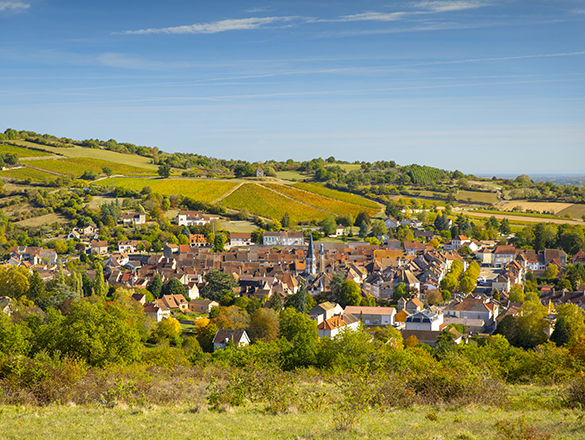
The vineyards of Bourgogne produce some great wines with a historical and international reputation. However, the region is not simply limited to its iconic appellations. In addition to its Village Premier Cru and Grand Cru AOCs, it also produces a range of wonderful Régionale and Village appellations to explore.
You will also find a full list of the Bourgogne’s Climats and lieux-dits on this page.
Check out the complete list of the 84 Bourgogne appellations.
However, your exploration has only just begun. Bourgogne wines have never before offered such high quality. Besides our range of internationally celebrated wines, try some of our lesser-known appellations where there are lots of surprises in store.
And for a fun way to find out more about the wines on offer, try out our “Which Bourgogne wine is right for me?” quiz, or check out Bourgogne Maps to take an interactive tour of the region.
Regional Appellation
VIGNOBLE DU MÂCONNAIS
31 juillet 1937
Whites - Chardonnay.
Reds and rosés - Gamay.
Area under vine:
Whites: 2.82 ha
Reds and rosés: 6.04 ha
Annual harvest:
Whites: 16,004 bottles
Reds and rosés: 39,768 bottles
Source: 5-year average, 2017-2021
An additional geographical denomination that is part of the Régionale Mâcon appellation in the Mâconnais. According to the 2005 specifications rules, the name Mâcon followed by Saint-Gengoux-le-National refers to white, red, and rosé wines grown within a defined area in the villages of Ameugny, Bissy-sous-Uxelles, Bonnay, Bresse-sur-Grosne, Burnand, Champagny-sous-Uxelles, Chapaize, Cortevaix, Curtil-sous-Burnand, Lournand, Malay, Saint-Gengoux-le-National, Saint-Ythaire, Salornaysur-Guye, Savigny-sur-Grosne, Sigy-le-Châtel, and La Vineuse.

With a lovely matte yellow gold color, the whites have a very aromatic nose marked by hints of almond and yellow-fleshed fruit like apricot and peach, combined with a slightly honeyed floral palette that comes with time. They offer good volume in the mouth with a fattiness making it smooth and supple.
A light and dazzling ruby red color, these reds open on notes of pomegranate and redcurrant jelly, giving them an indulgent fruitiness. Aeration releases a warm spiciness with hints of cinnamon and white pepper and touches of animal muskiness. In the mouth, the tannins are present yet smooth, giving a sense of indulgence.

White: With its sunny aromatic character and smoothness on the tongue, this wine makes a natural pairing with all kinds of goat cheeses, such as the traditional AOC Mâconnais or its neighboring Charolais for a terroir-themed aperitif. Follow with grilled chicken supremes or mixed fried river fish. This white wine will also bring out the best in local freshwater fish dishes, such as carp with white wine, or pôchouse from Verdun-sur-le-Doubs.
Serving temperatures: 10-11°C as an aperitif, 11-12°C with food
Red: serving this red slightly chilled at a chic brunch, with a traditional mâchon bourguignon selection of local cold cuts, cheeses, and fruit tarts.Its spicy nose and fleshy structure will perfectly suit a bacon-filled brioche from the Morvan with some salad from the garden. It will also make a great match with a summer-fruit salad of gooseberries, redcurrants, blackcurrants, and raspberries, served with sponge fingers.
Serving temperature: 12-14°C.

The vines of Mâcon-Saint-Gengoux-le-National are located at the extreme northwesterly tip of the Mâconnais. They act as the transition to the Côte Chalonnaise, growing on the first foothills.
In the early 12th century, the monks of Cluny established a deanery around the church dedicated to Saint Gengoux, which became the center of a farming operation that mainly produced wine. Wandering through this medieval town that was fortified by King Louis VII at the end of the 12th century, the names of the streets and the presence of a barrel-making museum bear witness to a great deal of artisanal and commercial activity.

The vines of Mâcon-Saint-Gengoux-le-National are scattered between the hills of Cluny and the foothills of the Côte Chalonnaise, at 250 meters above sea level, looking down the valley of the Grosne river. The riverbanks enjoy a temperate climate with a slightly continental tendency, in geological terms, there are two key terroirs. The hills of Roch, Goubot, and Péjus mark the boundaries of the Saint-Gengoux AOC and provide ideal south-southeasternfacing winegrowing terrain on their limestone hillsides. To the southwest, the vines face west or east and grow more episodically on Liasotriasic limestone clay marl that dates back 220 million years.
